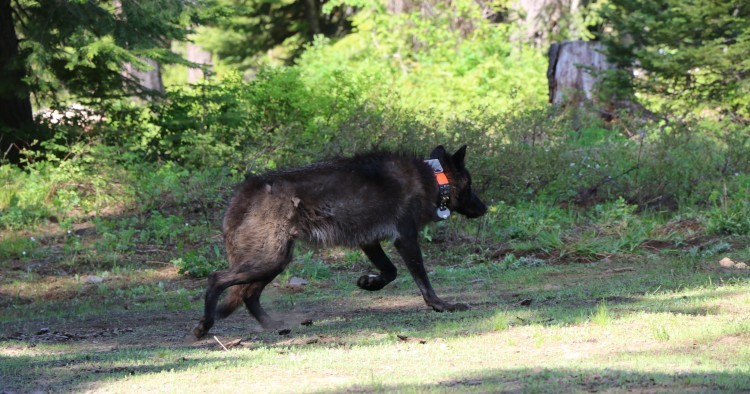
On March 31, OR4, a wolf named and tagged by the Oregon Department of Fish and Wildlife (ODFW), was shot and killed by officials along with his current mate, OR39, and their two-year-old pups. Wildlife officials had determined that they had killed four calves and a sheep on private pastureland during March. Under the current Oregon wolf management plan, that qualified as chronic depredation and allowed the killing of the wolves.
While the death of OR4 has received both strong opposition and support, there’s no denying OR4 was a special animal. “He had a heck of a personality. He was tenacious and had a real impact on people,” says wolf activist Rob Klavins. “He definitely beat the odds.”
OR4 first came to Oregon by way of Idaho’s Snake River in early 2008. His first mate, OR2, crossed the river about the same time but was collared first. (ODFW labels wolves with a number indicating the order in which they were collared.) The two became the first breeding pair in Oregon since 1947, and became known as the Imnaha pack. Their offspring include a number of wolves that dispersed or left to find their own territory, including OR3, who disappeared for several years but recently re-appeared in the Cascades; OR7, which in 2012 became the first wolf to enter California in 87 years; and the uncollared alpha female of the Shasta pack, the first gray wolf pack in California since 1924. That pack is expected to soon produce its second litter and is protected by the California Endangered Species Act.
Most wolves live about half as long as OR4, who was ten years old when he was shot, and as such, data from OR4’s collars has proven particularly valuable. For one, it has demonstrated the size of territory a wolf needs with the pack ranging over more than 950 square miles, says ODFW biologist Russ Morgan. Collar data also showed that OR4, in his prime, gathered food 25 or 30 miles from his pups’ den. “A lot of what we know about wolves in Oregon came from this wolf,” Morgan says.
Oregon had at least 110 wolves in 2015 in 12 packs, 11 of them breeding pairs. The presence of at least four breeding pairs for three consecutive years in the eastern part of the state triggered Phase II of the state’s wolf management plan, which required ODFW to consider removing wolves from the state Endangered Species list. The ODFW Commission did so on November 9, 2015.
ODFW issued at least one previous kill order on OR4, in 2011, which was halted by a court order at the last minute. Following that incident, changes were negotiated to the wolf plan to require four confirmed predations within a six-month period and use of a certain number of nonlethal tools to resolve wolf/livestock conflict before a kill order.
Overall, wolf depredation of livestock has decreased in Oregon even as the wolf population has increased. The March killings likely happened because of OR4’s age, his mate’s condition, and the fact that their year-old pups were not yet seasoned hunters. “We have reason to believe he was cast out of the Imnaha pack earlier this year,” Klavins added. “They were a very devoted pair, he never left her side. They just couldn’t hunt effectively anymore. So he ended up staying in one place and preying on livestock. You can’t blame them.”
Morgan said that even those in the livestock business had a grudging respect for OR4. “He had a long and difficult life. Wolves are capable predators, but they don’t have easy lives. OR4 really has quite a story. “We manage these animals at the interface of wild land and humans. There will be problems, and this got to the point we had to do something. But it didn’t come as an easy recommendation.”
“To picture him being chased down by a helicopter while his mate and pups are shot is a hard way to see him end,” Klavins said. “Many people hoped he would go the way that wolves are supposed to go.”
Amaroq Weiss of the Center for Biological Diversity hopes his death results in the public questioning the management of wolves in Oregon. “The loss of OR4 should not become simply another case of another wolf killed on behalf of the livestock industry,” Weiss said. “I hope his death raises some serious questions among the public about the way wolves are managed on behalf of special interests. He didn’t just belong to Oregon, he belonged to the entire world.”
Source: Life and Legacy of OR4, Oregon’s Most Celebrated Wild Wolf – Men’s Journal
